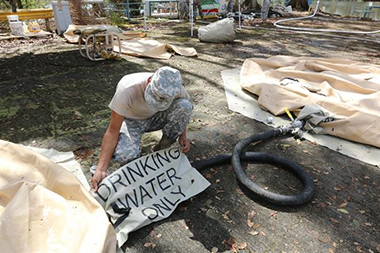Maria Aftermath
 |
|
A U.S. Army reservist protects precious drinking water for the residents of Puerto Rico, after Hurricane Maria exposed the island's vulnerable infrastructure. |
ALBANY, N.Y. (November 6, 2016) — The devastation left in Puerto Rico by Hurricane Maria has exposed the entrenched poverty, the crisis in political leadership and U.S. under-funding that has existed for more than a half century on the island, says a UAlbany political economist. But, as he writes in The Conversation, it may also be the spark that brings about critical change.
Pedro Caban, professor and chair of Latin American, Caribbean and U.S. Latino Studies. wrote on Sunday, in “Maria will fundamentally change US policy toward Puerto Rico,” that the hurricane has “exposed the crisis within Puerto Rico’s divided politics” between the Statehood and Commonwealth parties. Both, he said, share responsibility for the island’s escalating debt, and neither has been able to stop Puerto Rico’s economic decline.”
 |
|
Professor Pedro Caban. |
In presenting his argument that the plight of those living in the commonwealth remains largely ignored, Caban looks historically at two other catastrophic hurricanes, San Felipe II in 1928 and San Ciprían in 1932, that struck the island, causing more than 500 deaths and property damage worth more than $2 billion in today’s dollars.
The U.S. federal government response to those two events led to an acknowledgment of the neglect caused by colonial rule and the eventual creation of the Commonwealth of Puerto Rico in 1952, in which the island’s government was unofficially given autonomy to manage domestic affairs, including the economy.
More is needed now in ending the island’s internal mismanagement and political inaction, as well as the United States’ “continued treatment of Puerto Rico as ‘foreign to the United States in a domestic sense,’” which, he writes, “have an uncanny resemblance to the situation 1932.”
The Conversation is an independent source of news and views from the academic and research community. Articles are published online and are reprinted in news and media outlets nationwide.
To read the full article, go here.
![]() For more news, subscribe to UAlbany's RSS headline feeds
For more news, subscribe to UAlbany's RSS headline feeds
A comprehensive public research university, the University at Albany-SUNY offers more than 120 undergraduate majors and minors and 125 master's, doctoral and graduate certificate programs. UAlbany is a leader among all New York State colleges and universities in such diverse fields as atmospheric and environmental sciences, business, education, public health,health sciences, criminal justice, emergency preparedness, engineering and applied sciences, informatics, public administration, social welfare and sociology, taught by an extensive roster of faculty experts. It also offers expanded academic and research opportunities for students through an affiliation with Albany Law School. With a curriculum enhanced by 600 study-abroad opportunities, UAlbany launches great careers.


